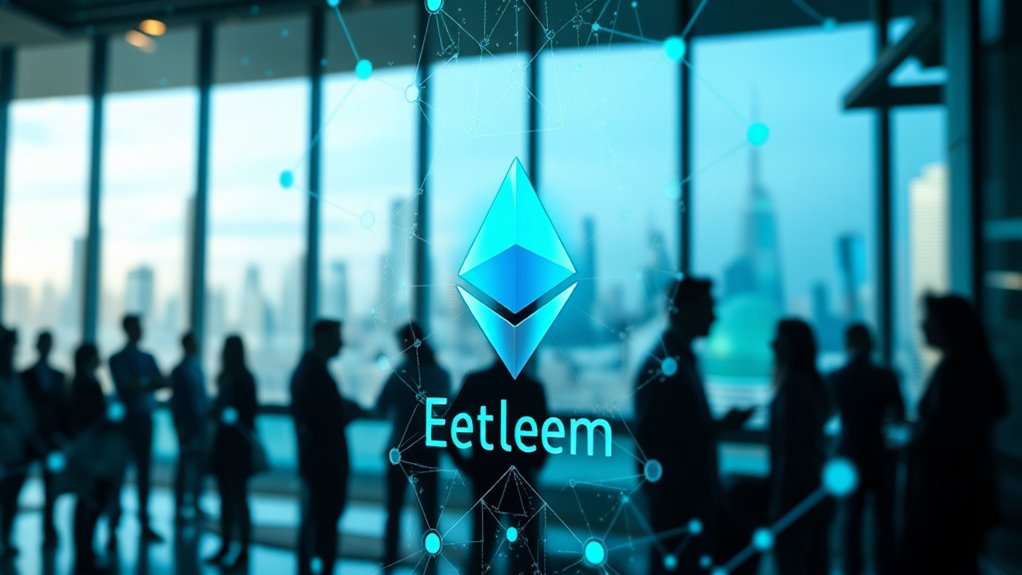
Future of Ethereum: What Trends to Expect Next?
Ethereum’s future centers on Layer 2 solutions addressing scalability concerns, with $16 billion already locked in protocols like Polygon and Arbitrum. The changeover to Ethereum 2.0 continues with sharding implementation potentially increasing capacity to 100,000 transactions per second. Institutional ownership has tripled recently, suggesting growing mainstream acceptance. Environmental improvements remain significant after the 99% energy reduction from Proof of Stake. Regulatory developments and DeFi expansion will shape how this foundational blockchain evolves.
Key Takeaways
- Layer 2 solutions will continue expanding, with TVL likely to exceed $20 billion as rollup technology matures.
- Sharding implementation will dramatically increase transaction throughput from 15 to potentially 100,000+ transactions per second.
- Institutional adoption will accelerate, with financial giants increasing their ETH ETF holdings beyond the current 14.5%.
- Post-Cancun upgrades will further reduce gas fees, making DeFi applications more accessible to mainstream users.
- Regulatory clarity will emerge as jurisdictions develop frameworks specifically addressing Ethereum’s unique position in blockchain ecosystems.
Layer 2 Solutions: The Next Frontier for Ethereum Scalability

As Ethereum continues to face substantial challenges with network congestion and high transaction fees, Layer 2 solutions have emerged as vital infrastructure to address these scalability issues.
Layer 2 solutions have become critical infrastructure in Ethereum’s battle against congestion and prohibitive transaction costs.
These off-chain scaling methods process transactions externally while inheriting security from the main blockchain.
With approximately $16 billion currently locked in Layer 2 protocols, solutions like Polygon, Optimism, zkSync, Arbitrum, and Base offer varied approaches to scalability.
By handling transactions off-chain, these solutions greatly increase throughput and reduce fees.
Despite their advantages, Layer 2 solutions face challenges including fragmentation of liquidity across multiple chains, interoperability issues, and varying degrees of technical complexity.
Moreover, rollups bundle multiple transactions into a single batch for submission to the Ethereum mainnet, which significantly enhances efficiency.
Nevertheless, their continued development remains essential for Ethereum’s long-term viability, especially as user and developer adoption grows.
The Road to Ethereum 2.0: Sharding and Beyond

While Layer 2 solutions offer immediate scaling benefits, the Ethereum network continues its ambitious evolution through a series of upgrades collectively known as Ethereum 2.0.
Central to this transformation is sharding, which divides the network into 64 segments that process transactions in parallel, potentially increasing throughput from 15 to over 100,000 transactions per second.
The change began with the Beacon Chain launch in December 2020, followed by the shift to Proof of Stake, markedly reducing energy consumption. This transition to Proof of Stake has not only made Ethereum more energy-efficient but also laid the groundwork for future innovations in the network.
Upcoming developments include the Cancun-Deneb upgrade with Proto-Danksharding, scheduled for testing in January 2024. This precursor to full Danksharding focuses on data sharding to reduce storage costs and enhance rollup scaling.
Despite implementation challenges, particularly in inter-shard communication, these advancements promise greater decentralization by lowering hardware requirements for validators.
Institutional Adoption: How Big Players Are Reshaping Ethereum’s Future

Institutional investors have dramatically transformed Ethereum’s landscape in recent months, with ownership of ETH ETFs surging from 4.8% to 14.5% between Q3 and Q4 2024. Major financial institutions like Goldman Sachs, Millennium Management, and Brevan Howard Capital now control over $400 million worth of ETHA shares, outpacing Bitcoin ETF adoption rates.
This increasing institutional presence offers potential market stabilization and signals confidence in Ethereum’s long-term viability. Financial giants are incorporating Ethereum into broader investment strategies, attracted by its technological applications beyond cryptocurrency. As these institutions engage with Ethereum, they are likely to explore opportunities within the DeFi protocols that enhance financial interactions and asset management.
Though price action remains stagnant despite this interest, the ecosystem continues expanding through DeFi, NFTs, and DAOs.
Ethereum builds silently behind price inertia, weaving strength through decentralized applications despite market hesitation.
The future looks promising as discussions around ETF staking features emerge, but Ethereum must navigate regulatory challenges and maintain its competitive edge against rival blockchain platforms.
Regulatory Landscape: Navigating Compliance in the Ethereum Ecosystem

The regulatory framework surrounding Ethereum presents a complex maze of evolving standards and jurisdictional variations that operators must navigate alongside the technical innovations driving the ecosystem.
As countries develop different approaches to cryptocurrency oversight, Ethereum-based businesses face substantial challenges in maintaining global compliance.
The classification of Ethereum as a security remains contentious, with the Howey Test often at the center of legal debates. This uncertainty affects investor confidence and institutional participation.
Meanwhile, regulatory sandboxes are emerging as potential solutions, allowing for controlled innovation while maintaining oversight.
The decentralized nature of Ethereum further complicates enforcement efforts, though increasing international cooperation suggests progress toward harmonized regulations that could streamline compliance without stifling the technological advancement that defines the platform. Furthermore, recent changes in regulatory frameworks indicate a potential shift towards more innovation-friendly regulations, which could positively impact Ethereum’s growth and adoption.
DeFi Evolution: Ethereum’s Role in the Next Generation of Financial Services

As decentralized finance (DeFi) continues to reshape traditional financial systems, Ethereum stands at the forefront of this revolution, providing the foundational infrastructure for innovative financial services that operate without central authorities.
Despite competition from other blockchains, Ethereum maintains its dominance in the DeFi landscape, evidenced by consistently growing Total Value Locked (TVL) across its protocols. The platform’s established smart contract ecosystem enables services ranging from lending and borrowing to decentralized exchanges, yield farming, and stablecoin creation.
Ethereum continues to lead DeFi innovation through its robust ecosystem despite emerging blockchain competitors.
Technological advancements like the shift to Proof-of-Stake and implementation of layer 2 solutions address previous scalability challenges, reducing transaction costs and improving user experience. Moreover, the ability to engage in peer-to-peer transactions on DeFi platforms enhances user autonomy and financial inclusivity.
These developments, coupled with increasing institutional interest, position Ethereum to remain central to DeFi’s evolution while supporting broader economic participation.
Cross-Chain Interoperability: Breaking Down Blockchain Silos

Cross-chain interoperability represents one of Ethereum‘s most significant technical frontiers, extending the blockchain’s capabilities beyond its native ecosystem. Ethereum continues to dominate cross-chain flows, with protocols like LayerZero and Hyperlane connecting it to numerous other networks.
Recent innovations include intent-centric bridging, which simplifies user interactions by focusing on desired outcomes rather than transaction specifics. The Ethereum Foundation’s Open Intents Framework further enhances cross-chain communication capabilities.
Despite these advances, challenges persist. Security vulnerabilities in smart contracts used for bridging create exploitation risks, while economic attacks and oracle manipulation remain concerns.
The complexity of integrating diverse blockchain architectures also poses technical hurdles.
Nevertheless, interoperability delivers substantial benefits, including reduced network congestion, improved user experiences, and maximized liquidity across multiple chains. As Ethereum continues to evolve, its role in facilitating decentralized finance (DeFi) will further drive adoption and innovation across the blockchain landscape.
Environmental Impact: Ethereum’s Transition to a Greener Blockchain

Following Ethereum’s shift from Proof of Work to Proof of Stake in 2022, the blockchain has transformed its environmental profile dramatically, reducing energy consumption by over 99%.
This change has positioned Ethereum as an environmentally responsible alternative in the cryptocurrency space, with current emissions at just 870 tonnes of CO2e annually—compared to its previous 27.5 million tons.
The environmental improvements can be quantified in several ways:
- Energy usage dropped to approximately 0.0026 TWh per year, far less than data centers (190 TWh) and video gaming (34 TWh).
- Carbon emissions fell from equivalent to Honduras’ national output to nearly negligible levels.
- Validator selection now uses staked ether rather than energy-intensive computations.
- Future innovations like sharding and Layer 2 solutions promise further efficiency gains without increased energy demands.
Additionally, this environmentally responsible alternative continues to attract a wider range of users who prioritize sustainability in their transactions.
Frequently Asked Questions
How Will Quantum Computing Affect Ethereum’s Security?
Quantum computing poses a significant threat to Ethereum’s security by potentially breaking its cryptographic algorithms. However, ongoing development of post-quantum cryptography and implementations like ZKnox aim to address these vulnerabilities before quantum computers become practical threats.
Can Ethereum Maintain Dominance if Major Tech Companies Launch Blockchain Alternatives?
Ethereum’s dominance faces challenges if tech giants launch blockchain alternatives. However, its established ecosystem, developer community, and ongoing improvements like PoS and sharding could help maintain its competitive position against corporate entrants.
What’s the Future of Ethereum Governance and Decision-Making Processes?
Like an old parliament evolving, Ethereum’s governance is shifting from founder-centric to community-driven models. Governance tokens and DAOs will likely expand decision-making authority, creating more decentralized processes while balancing innovation with stability.
How Might Global Economic Downturns Impact Ethereum’s Development Timeline?
Economic downturns could delay Ethereum’s development by reducing funding, developer resources, and institutional investment. However, challenging markets may also accelerate innovation focused on efficiency, security, and real-world utility to maintain competitive advantage.
Will Ethereum Eventually Need a Complete Codebase Redesign?
Ethereum’s codebase faces colossal challenges. While complete redesigns like Beam Chain exist as proposals, the platform typically favors incremental upgrades. Future development will likely continue this pattern, balancing innovation with ecosystem stability and security concerns.
Conclusion
Like a phoenix rising from digital ashes, Ethereum continues to transform. The network’s evolution through Layer 2 scaling, shift to Proof-of-Stake, institutional adoption, and cross-chain compatibility positions it at blockchain’s forefront. As regulatory frameworks mature and environmental concerns are addressed, Ethereum’s infrastructure will likely remain foundational for decentralized finance and applications, though challenges in governance and competition will test its resilience in coming years.












